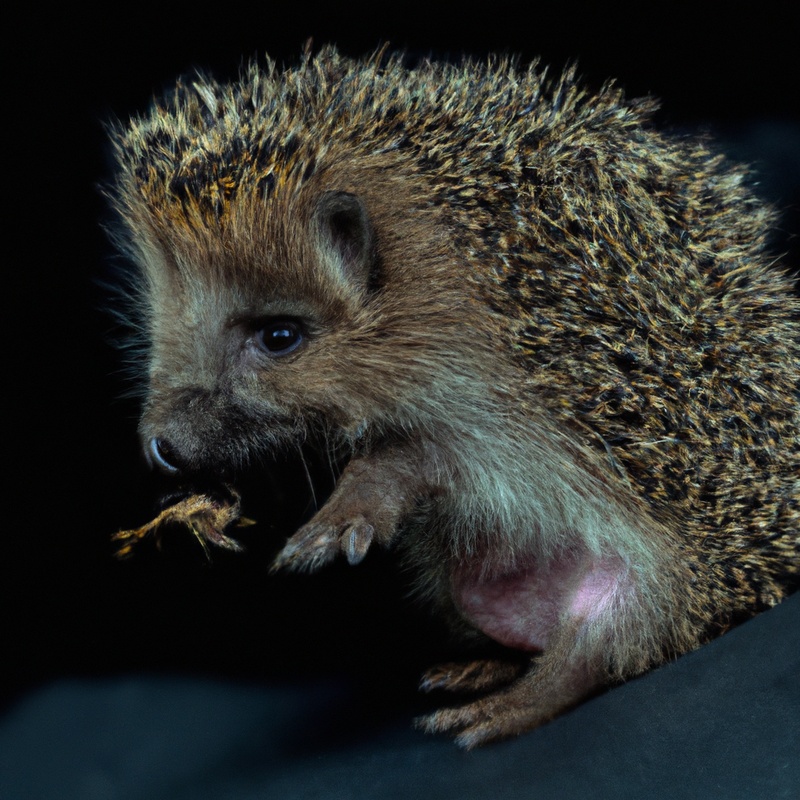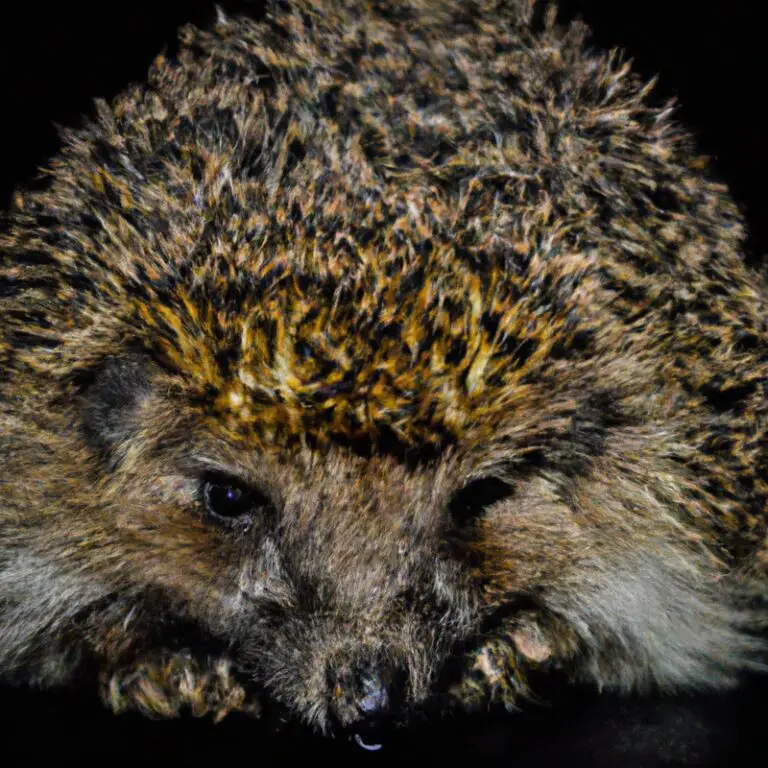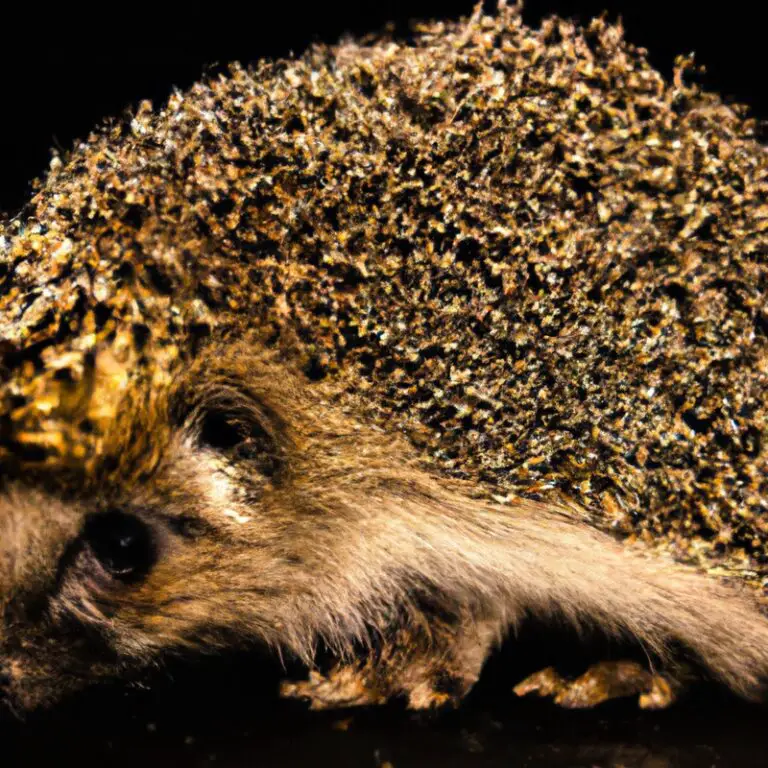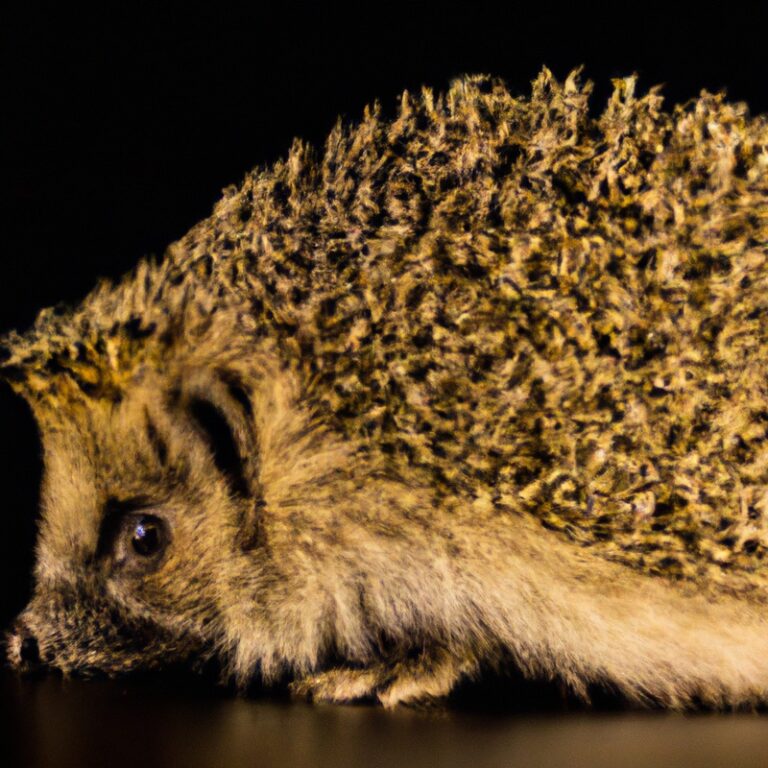What Is The Social Behavior Of Hedgehogs?
Key Takeaways:
- Hedgehogs are solitary animals that prefer to live alone rather than in groups.
- Hedgehogs communicate through a combination of vocalizations, body language, and scent marking.
- Hedgehogs display a range of social behaviors, including both aggressive and submissive interactions.
- Hedgehogs have a complex mating ritual, involving courtship displays and scent marking to attract a mate.
Have you ever wondered what goes on in the social lives of hedgehogs? Surprisingly, these prickly creatures aren’t as solitary as you might think.
They have their own intricate social behaviors and interactions that are both fascinating and adorable.
From communication methods to mating rituals, hedgehogs exhibit a range of social behaviors that make them intriguing creatures to study and observe. In this article, we will delve into the world of hedgehog social behavior, exploring their interactions in the wild and as pets.
Get ready to discover the captivating social lives of these adorable spiky creatures!
| Characteristic | Social Behavior of Hedgehogs |
| Grouping | Solitary |
| Social Structure | Individuals are territorial and generally do not form social bonds |
| Communication | Primarily through scent marking, vocalizations, and body postures |
| Reproduction | Males and females come together only briefly for mating |
| Parental Care | Females raise the young on their own without any assistance from males |
| Aggression | Hedgehogs may display aggression towards each other when competing for territories or mates |
| Hibernation | During hibernation, hedgehogs typically seek shelter individually and do not hibernate in groups |
| Compatibility | Hedgehogs are not typically compatible with other hedgehogs and may exhibit aggressive behavior towards each other if housed together |
Understanding Hedgehogs’ Social Behavior
Hedgehogs have unique social behaviors that are important to understand.
What Makes Hedgehogs Social Animals
Hedgehogs are social animals because they engage in various social behaviors. They often form small groups called ‘prickles.’ Hedgehogs use vocalizations and scents to communicate with each other.
They also engage in mutual grooming, which helps them bond and establish social hierarchies.
Hedgehogs are known to display communal nesting, where multiple individuals share the same nest during hibernation. These social interactions are important for their well-being and overall social development.
So, if you come across a hedgehog, remember that they thrive in social environments.

Hedgehogs in the Wild
Hedgehogs in the wild are independent creatures that prefer a solitary lifestyle.
They are nocturnal, which means they are active mainly during the night.
Hedgehogs are skilled predators and forage for insects, snails, and worms using their sharp senses of smell and hearing.
They have a wide habitat range, from gardens and parks to forests and meadows.
These animals are known for their ability to roll into a tight ball when threatened, using their spines for defense.
Hedgehogs in the wild also play a vital role in ecosystems by controlling pest populations.
Social Interactions Among Hedgehogs
Hedgehogs are generally solitary animals, but they do engage in social interactions at certain times.
During mating season, male hedgehogs will compete for the attention of females, which can involve aggressive behavior.
However, they also communicate with each other through various vocalizations, scents, and physical gestures.
Hedgehogs may socialize with each other while foraging for food or during brief encounters, but they typically maintain their own territories and prefer to be alone.
So, even though social interactions are not a major part of their behavior, hedgehogs still have some level of social interaction.
Communication Methods of Hedgehogs
Hedgehogs communicate in various ways, relying on their senses and body language. They make low-pitched vocalizations, such as snuffling and huffing, to express contentment or distress.
They also use quills and spine raising, huffing, and hissing to signal aggression or fear.
Hedgehogs have a keen sense of smell, which they use to identify each other, locate food, and communicate with other hedgehogs. Additionally, they use touch to build social bonds, exploring and nuzzling each other.
Overall, hedgehogs have a unique set of communication methods that allow them to interact with their environment and communicate their needs to others.
Mating Season and Reproduction
Mating season for hedgehogs typically occurs during the late spring and early summer months. During this time, male hedgehogs will search for a mate.
They do this by sniffing out the scent of a female hedgehog.
Once they find a female, they engage in a courtship ritual that involves circling around each other and making various vocalizations. Mating itself is a quick process, lasting only a few minutes.
After mating, the female will go on to give birth to a litter of hoglets, usually between three to seven babies.
Hedgehogs are solitary animals and do not exhibit any significant social behavior after mating.
Caring for Hedgehog Babies
Caring for hedgehog babies is a delicate task that requires attention and knowledge. Here are a few tips to help you take care of them:
- Provide a warm and safe environment for the babies. Ensure the temperature is between 73-80°F (23-27°C and keep them away from drafts.
- Feed them a balanced diet of commercial hedgehog baby food or a mixture of high-quality cat food and cooked vegetables or fruit.
- Handle them gently and minimally, as excessive stress can be harmful to their health. Wash your hands before handling them to avoid transmitting any bacteria.
- Regularly clean their enclosure and provide fresh bedding to maintain hygiene.
- Monitor their growth and weight to ensure they are developing properly. Seek veterinary care if you notice any unusual behavior or health issues.
Remember, caring for hedgehog babies requires patience and attention to detail. By providing a nurturing environment and meeting their nutritional and safety needs, you can help them thrive.
Hedgehogs as Pets: Socializing and Bonding
Socializing and bonding with your pet hedgehog is important for their well-being.
Spend time with them daily, talking and handling them gently to build trust.
Offer treats and play with them using toys.
Ensure a calm and quiet environment.
Avoid sudden movements or loud noises that can startle them.
Each hedgehog has a unique personality, so be patient and understanding of their boundaries.
With time and effort, you can develop a strong bond with your hedgehog.
Frequently Asked Questions about Hedgehog Social Behavior
FAQs about Hedgehog Social Behavior:
1. Are hedgehogs social animals?
Hedgehogs are generally solitary animals and prefer to live alone. They do not form social groups or live in packs like some other animals.
However, they can tolerate the presence of other hedgehogs in their territory.
2. Do hedgehogs interact with each other?
While hedgehogs may interact briefly during mating season, they are not known to engage in social interactions with other hedgehogs. They mainly communicate through scent marking and vocalizations to establish territory boundaries.
3. Can hedgehogs live together?
In most cases, it is not recommended to keep multiple hedgehogs together as they may become agitated or aggressive towards each other. It’s best to provide each hedgehog with its own separate living space.
4. Do hedgehogs get lonely?
Hedgehogs do not experience loneliness in the same way humans do. They are solitary animals by nature and are generally content when provided with the appropriate environmental enrichment, such as toys, tunnels, and hideouts.
5. Can hedgehogs bond with humans?
Hedgehogs can form a bond with humans through regular handling and interaction. While they may not display the same level of attachment as dogs or cats, they can recognize their owners and become familiar with their scent and voice.
6. How do hedgehogs communicate with humans?
Hedgehogs communicate with humans through a combination of vocalizations, body language, and scent marking. They may make soft clicking or chirping sounds, huff or puff when agitated, and express contentment through relaxed body posture and quill laying.
7. Are hedgehogs territorial?
Yes, hedgehogs are territorial animals. They mark their territory with scent glands located on their bodies and exhibit behaviors like head shaking, urine marking, and spiky displays to deter others from entering their space.
Remember, each hedgehog may have its own unique personality and behavior.
It is crucial to give them space and respect their individual preferences.
What Makes Hedgehogs Social Animals
Hedgehogs are social animals due to their natural instincts and the benefits they receive from socialization.
The Nature of Hedgehogs’ Social Behavior
Hedgehogs are naturally solitary animals, meaning they usually prefer to live alone rather than in groups. However, they do display some social behavior.
Hedgehogs are known to communicate using a variety of vocalizations, such as snorting, hissing, and chirping.
They may also engage in mutual grooming, where they clean each other’s spines. Additionally, hedgehogs have been observed forming temporary social groups during hibernation or when food is abundant.
While not as social as some other animals, hedgehogs still demonstrate some level of social interaction.
Benefits of Socialization for Hedgehogs
Socialization is important for hedgehogs as it provides numerous benefits for their overall well-being. Here are some advantages of socializing hedgehogs:
- Mental Stimulation: Interacting with other hedgehogs or even humans promotes mental stimulation, keeping them mentally active and engaged.
- Emotional Bonding: Socialization helps hedgehogs develop emotional bonds with their peers and humans. This strengthens their sense of security and improves their overall happiness.
- Behavioral Development: Socialization plays a crucial role in shaping hedgehog behavior. It helps them learn appropriate social cues, communication skills, and build confidence.
- Exercise: Socializing with other hedgehogs involves physical activities such as play, exploration, and exercise. This contributes to their physical well-being and helps maintain a healthy weight.
- Stress Reduction: When hedgehogs have regular opportunities to socialize, it can reduce their stress levels, as interaction and companionship help them feel more content and less anxious.
It’s important to note that socializing hedgehogs should be done gradually, ensuring their safety and comfort. Regular socialization is beneficial, but it’s essential to observe their behavior and adjust accordingly.
Hedgehogs’ Social Structures in the Wild
Hedgehogs in the wild exhibit a solitary lifestyle, preferring to live alone rather than in groups.
They establish territories and mark them with scent to communicate their ownership.
While they may encounter other hedgehogs during mating season, these interactions are brief and purely for reproductive purposes.
Hedgehogs are nocturnal animals, and their social interactions primarily revolve around finding food and avoiding predators.
Unlike some other animals, hedgehogs do not form complex social structures or engage in social behaviors such as grooming or playing with other individuals.
Hedgehogs in the Wild
Hedgehogs in the wild exhibit unique behaviors and adaptations for survival.
Group Dynamics in Wild Hedgehog Communities
In the wild, hedgehogs tend to lead solitary lives, but they do have some interesting group dynamics.
While they typically don’t interact with each other for extended periods, they may come together for breeding or during hibernation.
During these times, hedgehogs can form loose communities, sharing nests or burrows.
However, they still maintain their independence and do not display strong social bonding.
These occasional interactions allow them to meet their basic social needs without compromising their solitary nature.
Communication and Interactions with Other Species
Communication and Interactions with Other Species Hedgehogs are primarily solitary animals, but they do have some interactions with other species.
They communicate with other animals through scent marking, vocalizations, and body language.
Hedgehogs often encounter other mammals, such as foxes and cats, and their response can vary from defensive behavior to simply ignoring them.
They have also been known to interact with birds, insects, and even humans.
It’s important to remember that each hedgehog’s response to other species can be different, so it’s essential to observe and understand their individual behaviors and reactions.
Hedgehogs’ Foraging Behavior in a Social Context
Hedgehogs’ foraging behavior is influenced by their social context.
In the wild, hedgehogs often forage alone, searching for insects, snails, and other small prey.
However, they may come together with other hedgehogs when food is abundant or during mating season.
During these social foraging events, hedgehogs communicate using a variety of sounds and behaviors.
They may share information about food sources, establish dominance hierarchies, and even engage in cooperative hunting.
Understanding the social aspects of hedgehogs’ foraging behavior can provide valuable insights into their survival strategies.
Social Interactions Among Hedgehogs
Hedgehogs engage in various social behaviors, including scent marking, establishing territories, forming hierarchical structures, resolving conflicts, and developing social bonds through play.
Scent Marking and Territory Establishment
Scent marking is an important behavior for hedgehogs to establish their territory. Hedgehogs have scent glands located on their undersides, and they use these glands to leave their scent on objects in their surroundings.
This helps them communicate with other hedgehogs and warns potential intruders that the area is already claimed.
By marking their territory, hedgehogs can avoid unnecessary confrontations and ensure their safety. The scent marking behavior is crucial for hedgehogs to maintain their personal space and establish boundaries with other individuals.
Hierarchical Structures and Dominance
In hedgehog social groups, hierarchical structures and dominance play a significant role.
Hedgehogs establish a clear social order, with dominant individuals having higher status and priority access to resources.
Dominance is usually determined through aggressive interactions, such as spiky displays and physical confrontations.
The dominant hedgehog typically takes the lead in decision-making and territorial defense.
Hierarchical structures help maintain order and minimize conflicts within the group, ensuring a more stable social dynamic.
Dominance behavior is an essential aspect of hedgehog social behavior, allowing them to navigate and thrive in their natural environments.
Aggression and Conflict Resolution Among Hedgehogs
Hedgehogs can exhibit aggression towards each other, especially when they feel threatened or their territories are invaded. This aggression can manifest in behaviors such as hissing, spiking, chasing, and biting.
However, hedgehogs also have the ability to resolve conflicts.
One way they do this is through dominance displays, where they stand tall and try to intimidate each other. Another method is through submissive behaviors, such as curling up in a ball or retreating.
In some cases, hedgehogs may engage in a brief fight to establish their position, but this is usually resolved quickly.
Overall, hedgehogs have their ways of dealing with conflicts and maintaining social order.
Play Behavior and Social Bonding
Play behavior is an important aspect of social bonding among hedgehogs.
It helps them establish and strengthen relationships with others in their group.
During play, hedgehogs engage in activities like chasing, pouncing, and rolling around together.
This behavior not only promotes physical fitness and coordination but also enhances social communication and bonding.
Playful interactions contribute to the development of social hierarchies and the formation of lasting social bonds among hedgehogs.
Communication Methods of Hedgehogs
Hedgehogs use vocalizations, body language, visual signals, and chemical communication to communicate with each other.
Vocalizations and Their Meanings
Hedgehogs use vocalizations to communicate with each other and express their feelings. Here are some common vocalizations and their meanings:
- Snorting: A snorting sound usually indicates that the hedgehog feels threatened or is being defensive. It’s a sign that they are trying to warn potential predators to stay away.
- Purring: Hedgehogs also make a purring sound, similar to a cat’s purr, when they are content and relaxed. This is often heard when they are being petted or during moments of calm.
- Hissing: If a hedgehog is hissing, it means they are feeling agitated or scared. They may hiss in response to something that is causing them discomfort or fear.
- Chirping: Hedgehogs may make a chirping sound when they are excited or happy. It’s a playful vocalization that can often be heard during moments of exploration or when they are interacting with toys.
By paying attention to these vocalizations, you can better understand your hedgehog’s feelings and provide them with the right care and environment.
Body Language and Visual Signals
Body language and visual signals play a significant role in the social behavior of hedgehogs. They use various gestures and postures to convey their feelings and intentions.
For example, when a hedgehog feels threatened, it may roll into a tight ball, exposing only its spines.
On the other hand, if it feels comfortable and relaxed, it may stretch out its body and walk with a contented gait. Additionally, hedgehogs use visual cues, such as eye contact or bristling of quills, to communicate with each other.
It’s fascinating to observe how these subtle cues contribute to their social interactions.
Chemical Communication and Scent Marking
Chemical communication and scent marking are vital aspects of hedgehog social behavior.
Through chemical signals, hedgehogs can communicate with each other and mark their territory.
They achieve this by releasing specific odors through scent glands located on their bodies.
These odors convey important information about their identity, reproductive status, and territory boundaries.
Hedgehogs use scent marking to establish their presence and communicate with other hedgehogs in their vicinity.
By smelling and interpreting these chemical signals, hedgehogs can form social bonds and establish their hierarchy within a group.
Mating Season and Reproduction
During the mating season, hedgehogs engage in reproductive behavior and cycles to ensure successful reproduction. This includes mating behavior, courtship rituals, and distinctive reproductive strategies for both males and females.
Hedgehog Reproductive Cycles
Hedgehogs have distinct reproductive cycles influenced by the changing seasons.
They are known as seasonal breeders, meaning they mate and reproduce during specific times of the year.
The exact timing can vary based on factors like location and climate.
Typically, hedgehogs will enter into a period of breeding activity during the spring and summer months, when the weather is warmer and food is abundant.
After mating, the female hedgehog will go on to have a gestation period of around four to six weeks, before giving birth to a litter of hoglets.
It’s important to note that male hedgehogs are not involved in raising the offspring and may mate with multiple females during this time.
Hedgehog reproductive cycles are fascinating to observe and are essential for the survival of these endearing creatures.
Mating Behavior and Courtship Rituals
When it comes to the mating behavior of hedgehogs, courtship rituals play an important role.
Male hedgehogs initiate the courtship process by performing a series of behaviors to attract females.
They may sniff the female’s scent, produce vocalizations, and engage in a “dance” where they circle or follow her.
Once the female is receptive, mating occurs, usually in a brief and rapid manner.
After mating, the male typically leaves, and the female is left to gestate and raise the offspring on her own.
Hedgehogs are solitary animals, so their social behavior is limited to the courtship and mating process.
Female Reproductive Strategies
Female hedgehogs have several reproductive strategies to ensure the survival of their offspring. One of these strategies is called “delayed implantation,” where the fertilized eggs do not immediately implant in the uterus.
This allows the female to time the birth of her young in favorable conditions.
Additionally, female hedgehogs are known to exhibit promiscuous mating behavior, mating with multiple males during their receptive period. This ensures genetic diversity and increases the chances of successful reproduction.
Male Competition and Mate Selection
Male hedgehogs engage in competition for mates by displaying aggressive behaviors such as snorting, hissing, and even fighting with other males.
To attract a mate, male hedgehogs also produce vocalizations and engage in scent marking to establish their territory.
Female hedgehogs, on the other hand, have the final say in selecting their mates.
They may assess males based on their size, health, and dominance displays.
In the end, the most suitable male is chosen for mating, ensuring the survival and continuation of the species.
Caring for Hedgehog Babies
Caring for hedgehog babies involves understanding their unique needs and providing proper care and protection.
Pregnancy and Gestation Period
During pregnancy, female hedgehogs undergo a gestation period that typically lasts for about 35 to 40 days.
This is the time when the fertilized eggs develop inside the mother’s womb.
Hedgehogs are solitary animals, so they prefer to give birth and care for their young in private.
It is important to provide a comfortable and quiet space for the pregnant hedgehog, ensuring she has plenty of nesting material and a secluded area to give birth.
Monitoring the mother’s health and offering nutritious food is essential during this period.
Birth and Nursing Behaviors
In hedgehogs, birth and nursing behaviors are fascinating to observe. After a gestation period of about 35 days, the female hedgehog gives birth to a litter of 3 to 7 hoglets.
The hoglets are born with soft spines that harden within a few hours.
The mother hedgehog is quite attentive to her babies, nursing them several times a day. She provides them with milk rich in nutrients for their growth and development.
The hoglets nurse for about 4 to 6 weeks until they are ready to be weaned onto solid foods.
During the nursing period, the mother hedgehog stays close to the nest, rarely leaving her babies unattended. She keeps the nest clean by eating the hoglets’ waste.
This behavior helps prevent the accumulation of feces and keeps the nest hygienic.
As the hoglets grow older, they become more independent and start exploring their surroundings. By observing these birth and nursing behaviors, you can gain a deeper understanding of the fascinating world of hedgehogs.
Maternal Care and Protection
Maternal care and protection is incredibly important for hedgehog babies.
The mother hedgehog plays a crucial role in raising and nurturing her young.
She provides warmth and security by making a nest and carefully tending to her babies.
The mother also nurses and feeds her babies until they are ready to start eating solid food.
Hedgehog mothers are very attentive and protective, ensuring the safety and well-being of their offspring.
It’s fascinating to see the level of care these animals provide for their young.
Development and Weaning of Hedgehog Pups
Hedgehog pups go through a fascinating developmental process before they can become independent. At birth, they are blind, hairless, and entirely depend on their mother for warmth and nutrition.
Over the next few weeks, their quills will grow, and their eyes will open.
They will also start venturing out of the nest and exploring their environment. Weaning typically occurs around four to six weeks of age when the pups are capable of consuming solid food.
It’s important to provide them with a balanced diet during this stage to ensure their healthy growth.
Hedgehogs as Pets: Socializing and Bonding
Socializing and bonding with pet hedgehogs is essential for their well-being and your relationship with them.
Importance of Socialization for Pet Hedgehogs
Socialization is crucial for pet hedgehogs.
It helps them develop trust, reduce stress, and become more comfortable around humans.
By gradually exposing them to different people, sounds, and environments, you can enhance their social skills.
Interacting with your hedgehog regularly and providing positive experiences can build a strong bond between you and your pet.
Offering treats, gentle handling, and playtime can make socialization enjoyable for both of you.
Remember, every hedgehog is unique, so be patient and understanding as you help them navigate the social world.
Tips for Bonding with a Hedgehog
To bond with your hedgehog, start by giving them time to adjust to their new environment. Offer them treats and talk to them softly to get them used to your presence.
Handle them gently and regularly to build trust, but be careful of their spines.
Create a routine for feeding, cleaning, and playtime so they feel secure and comforted. Offer interactive toys to keep them stimulated and engaged.
Avoid sudden movements and loud noises that could startle them.
With patience and consistent positive interactions, you can build a strong bond with your hedgehog.
Potential Challenges and Solutions
Potential Challenges:
- Hedgehogs are nocturnal animals, so they may be active when you want to sleep.
- Hedgehogs have quills and may prick you if they feel threatened or scared.
- Hedgehogs are solitary creatures and may not necessarily enjoy human interaction.
Solutions:
- Create a quiet and dark sleeping area for your hedgehog to avoid disturbing your sleep.
- Handle your hedgehog gently and avoid sudden movements to minimize the chances of getting pricked.
- Provide your hedgehog with plenty of hiding spots and toys to keep them entertained and stimulated. Respect their need for personal space and allow them to come to you when they feel comfortable.
Creating a Social Environment for Pet Hedgehogs
Creating a social environment for pet hedgehogs is important for their well-being. Here are some tips:
- Provide a spacious cage with hiding spots for them to feel secure.
- Offer a balanced diet to keep them healthy and active.
- Spend time interacting with your hedgehog daily to build trust and bond with them.
- Provide mental stimulation through toys and puzzles.
- Consider having more than one hedgehog if they are social animals.
Remember, patience and consistency are key in creating a social environment for your pet hedgehog.
Frequently Asked Questions about Hedgehog Social Behavior
Can hedgehogs live alone?
Hedgehogs are solitary animals, and they can live alone without the company of other hedgehogs.
While they may tolerate being housed together briefly for breeding purposes, they prefer to have their own space and territory.
Hedgehogs are nocturnal creatures and are generally content with their own company.
However, it’s important to provide them with plenty of mental and physical stimulation through toys, exercise, and a varied diet to ensure their well-being.
Do hedgehogs form long-term bonds?
Hedgehogs do not form long-term bonds with other hedgehogs.
They are generally solitary animals and prefer to live alone.
While they may tolerate each other’s presence in certain situations, they do not seek out social interactions or rely on each other for companionship.
Hedgehogs are independent and self-sufficient creatures, perfectly content living their lives without forming long-lasting bonds with others of their kind.
How do hedgehogs communicate with each other?
Hedgehogs communicate with each other through a variety of methods. They use vocalizations like snorting, hissing, and squeaking to express different emotions and signals.
They also rely on body postures and movements, such as puffing up or rolling into a ball, to communicate their feelings.
Additionally, hedgehogs use scent marking to establish their territory and attract potential mates. Overall, hedgehogs have a unique and complex system of communication that allows them to interact with each other effectively.
Are hedgehogs aggressive towards humans?
Hedgehogs are generally not aggressive towards humans.
They are shy and reserved creatures who prefer to avoid confrontation.
While they may curl into a defensive ball when they feel threatened, this is their natural instinct for self-preservation rather than aggression.
It’s important to approach hedgehogs gently and give them plenty of space to feel safe and comfortable.
With patience and respect, you can have peaceful interactions with these adorable creatures.
How can I socialize my pet hedgehog?
Socializing your pet hedgehog is important for their well-being and to build a bond with them.
Here are some tips:
- Start early: Begin handling your hedgehog gently from a young age to help them get used to human interaction.
- Use a gentle approach: Avoid sudden movements or loud noises that may startle your hedgehog. Speak softly and move slowly around them.
- Build trust: Offer treats and rewards to create positive associations with interactions. This will help your hedgehog feel more comfortable around you.
- Gradually increase handling time: Start with short periods of handling and gradually increase the duration as your hedgehog becomes more comfortable.
- Provide a safe environment: Create a secure space for your hedgehog to explore and play. Ensure there are no hazards or escape routes.
- Offer enrichment: Provide toys, tunnels, and hiding spots to keep your hedgehog mentally stimulated and prevent boredom.
Remember, each hedgehog is unique, so be patient and respect their boundaries.
With time and consistency, you can successfully socialize your pet hedgehog.
Final Verdict
Hedgehogs are social animals with complex behaviors and interactions.
They establish hierarchies, communicate through vocalizations, body language, and scent marking, and engage in play and bonding.
In the wild, hedgehogs form communities, forage together, and interact with other species.
During mating season, they exhibit specific reproductive behaviors and care for their offspring.
As pets, hedgehogs require socialization and bonding with their human caregivers.
Understanding and promoting their social behavior is crucial for their well-being.
By providing a social environment and taking steps to build trust and connection, we can ensure happy, healthy hedgehogs.







